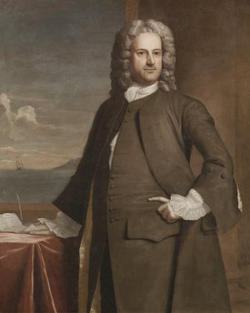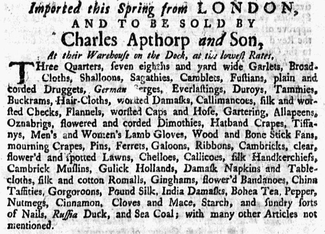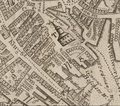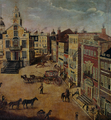- Charles Apthorp
-
 Portrait of Charles Apthorp, 1748 (by Robert Feke)
Portrait of Charles Apthorp, 1748 (by Robert Feke)
Charles Apthorp (1698–1758) was a British-born merchant in 18th-century Boston, Massachusetts. He ran his import business from Merchants Row, and "in his day he was called the richest man in Boston."[1] He acted for the British government, and supported King's Chapel.
Contents
Life and career
He was born in England in 1698 to John Apthorp and Susan Ward. He attended Eton College. "After the death of his father [he] came to New England."[2] In 1726 he married Grisselda "Grizzel" Eastwick (1710–1796).
Among the goods imported and/or sold through Apthorp on Merchants Row in Boston were "choice madera wines, ... a parcel of Russia duck and several sorts of European goods";[3] "British duck of all sorts";[4] "choice good sea coal, ... several second hand cables, little the worse for wear, and anchors suitable, with window glass of most sorts, and a parcel of lead and shot";[5] "a good new still and worm of about 600 gallons";[6] "Connecticut pork by the barrel";[7] salt;[8] "a parcel of guns, 4-pounders, with carriages and shott, also a parcel of swivel-guns with shott suitable;"[9] a "well fitted" 50-ton sloop";[10] and "a brigantine about 90 tuns, and three years old, now lying at the Long Wharfe".[11] In the 1730s and 1740s he repeatedly traded in slaves, for instance: "a parcel of likely negros just imported".[12]
In 1733 Apthorp acted as agent for a man seeking his servant, Hannah Smyth, who had run away with a stolen diamond "and has lately been seen here in Boston."[13] He performed a similar role in 1742, authorized to furnish "five pounds reward" for the return of a "negro man named Jack about 35 years old" to "his master Capt. Stephen Eastwick."[14] In 1756 Apthorp & Son served as agent for someone looking for an anchor lost on Cape Cod "with two iron clasps on one of the flukes, a solid pine buoy, and buoy-rope."[15]
Along with Thomas Hancock, Apthorp represented the British government in its efforts to recruit personnel to Nova Scotia -- ship pilots, bricklayers, carpenters, land settlers, etc.[16][17][18][19] He also served as "paymaster and commissary under the British Government of the land and naval forces quartered in Boston."[2] He was "one of the first wardens of Trinity Church"[2] and donated some 1,000 pounds to the "rebuilding" of King's Chapel.[2]
Apthorp and Hancock together supplied many of the boats used to ethnically cleanse Nova Scotia of the Acadians in the Great Upheaval. The firm also lent money to finance the operation. The poor quality of the ships led to widespread malnutrition, disease, and death among the deported Acadians.[20]
Apthorp's eighteen children included: Charles Ward Apthorp (later of Apthorp Farm); East Apthorp;[21][22] John Apthorp; Rebecca Apthorp;[23] Susan Apthorp (mother of architect Charles Bulfinch); Thomas Apthorp; and William Apthorp.[2] Among his grandchildren were Sarah Wentworth Apthorp Morton.[24]
Portraits were made of Charles Apthorp by Joseph Blackburn; John Singleton Copley;[25] and Robert Feke.[26][27] Among the Apthorp's personal possessions were "a set of eight chairs ... probably purchased from the chairmaker and upholsterer Samuel Grant, [with] carving ... attributed to John Welch."[28]
Apthorp died suddenly in November, 1758; he complained "of a slight cold a few minutes before he expired."[29] A New England newspaper reported "the greatest merchant on this continent is gone."[30] His "funeral was attended by very many gentlemen of distinction and principal inhabitants of the town. The streets and windows of the houses, as the solemnity passed along, were thronged with spectators. ... [At King's Chapel] the Reverend Mr. Caner preached a suitable sermon to a crowded audience."[31] A wall marker carved by Henry Cheere memorializes Apthorp inside King's Chapel; it "is crowned by a cherub weeping over a cinerary urn."[32]
See also
Images
References
- Notes
- ^ E. Bulfinch, ed. Life and letters of Charles Bulfinch, architect: with other family papers. Boston: Houghton Mifflin, 1896; p.32.
- ^ a b c d e James Henry Stark. The Loyalists of Massachusetts and the other side of the American revolution. Salem Press, 1910.
- ^ New England Weekly Journal.; Date: January 10, 1732
- ^ Boston Gazette; Date: From Monday December 13, to Monday December 20 1736
- ^ Boston Evening Post.; Date: December 12, 1737
- ^ New England Weekly Journal.; Date: May 5, 1741
- ^ Boston Weekly News-Letter; Date: December 30, 1742
- ^ Boston Evening Post.; Date: February 28, 1743
- ^ Boston Post Boy.; Date: October 16, 1758
- ^ Boston Gazette; Date: From Monday November 28, to Monday December 5, 1726
- ^ New England Weekly Journal.; Date: February 14, 1732
- ^ Boston Gazette; Date: From Monday July 25, to Monday August 1 1737
- ^ Boston Gazette; Date: From Monday August 13, to Monday August 20, 1733
- ^ Boston Post-Boy; Date: January 18, 1742
- ^ Boston Evening Post.; Date: June 7, 1756
- ^ Boston Evening Post, May 25, 1747
- ^ Boston Post Boy.; Date: March 27, 1749
- ^ Boston Gazette, Aug. 22, 1749
- ^ Boston Post Boy.; Date: September 4, 1749
- ^ Centre d'tudes acadiennes, Universit de Moncton. 1755. Retrieved 2010-04-16
- ^ Frank William Bayley. The life and works of John Singleton Copley: founded on the work of Augustus Thorndike Perkins. Taylor Press, 1915.
- ^ East Apthorp built in 1761 a mansion designed by Peter Harrison; it is now part of the Harvard University campus in Cambridge, Massachusetts. Cf. Douglass Shand-Tucci, Richard Cheek. Harvard University: an architectural tour. Princeton Architectural Press, 2001; p.104+
- ^ Boston News-Letter and New-England Chronicle; Date: March 20, 1766
- ^ a b Paul S. Harris. Gilbert Stuart and a Portrait of Mrs. Sarah Apthorp Morton. Winterthur Portfolio, Vol. 1 (1964)
- ^ Annual report of the Museum of Fine Arts Boston. 1903
- ^ Cleveland Museum of Art catalog. Retrieved April 16, 2010
- ^ Portrait of Charles Apthorp by Robert Feke. Bulletin of the Cleveland Museum of Art, Vol. 6, No. 5 (Jun., 1919)
- ^ Ann Smart Martin, Elvehjem Museum of Art. Makers and users: American decorative arts, 1630–1820, from the Chipstone collection. Chazen Museum of Art, 1999
- ^ New-Hampshire Gazette; Date: November 17, 1758
- ^ New-Hampshire Gazette; Date: November 17, 1758
- ^ Boston Weekly News-Letter; Date: November 24, 1758
- ^ Fiske Kimball. Beginnings of sculpture in colonial America. Art and Archaeology v.8, no.3, May-June 1919.
- Further reading
- Henry Caner. The nature & necessity, of an habitual preparation for death & judgment. A sermon preach'd at King's-Chapel in Boston, November 21st. 1758. Upon occasion of the death of Charles Apthorp, esq. Boston: New-England: Printed by John Draper, 1758.
- Foote. Annals of King's Chapel. Boston: Little, Brown, 1896. (Includes reproductions of portraits of Charles and Grizzell)
- John A. Schutz. Succession Politics in Massachusetts, 1730–1741. William and Mary Quarterly, Third Series, Vol. 15, No. 4 (October 1958), pp. 508-520.
External links
- WorldCat. Apthorp, Charles 1698-1758
- Portrait of Mrs. Charles Apthorp (Grizzell Eastwick Apthorp). By Robert Feke, 1748
- Newberry Library, Chicago. Charles Apthorp's outgoing correspondence to London merchant, John Thomlinson, dated from April 1738 to April 1739 and August 1751.
Categories:- 1698 births
- 1758 deaths
- People from Boston, Massachusetts
- Businesspeople from Massachusetts
- American slave traders
- 18th century in Boston, Massachusetts
Wikimedia Foundation. 2010.






